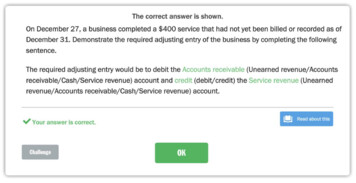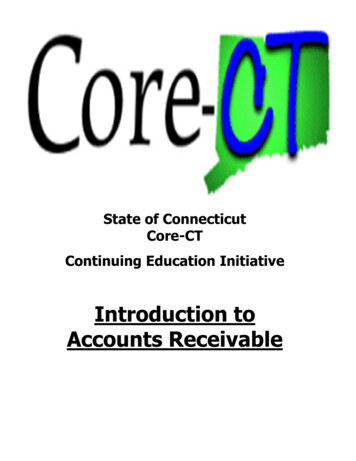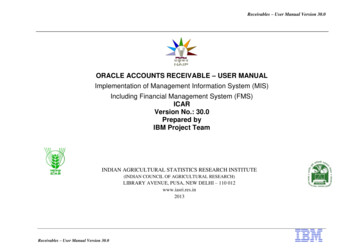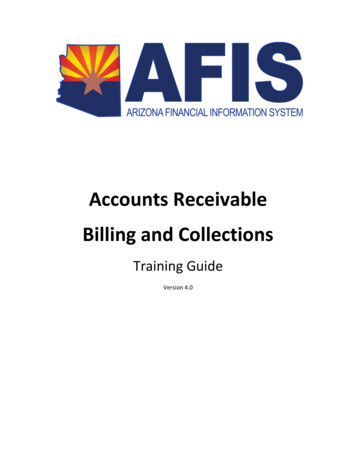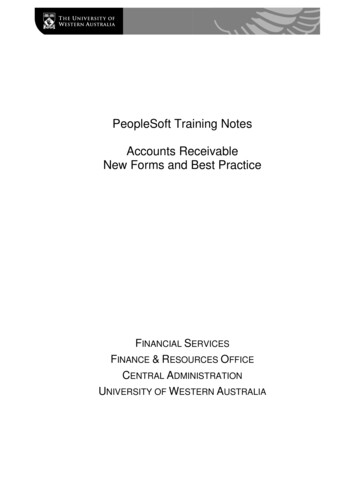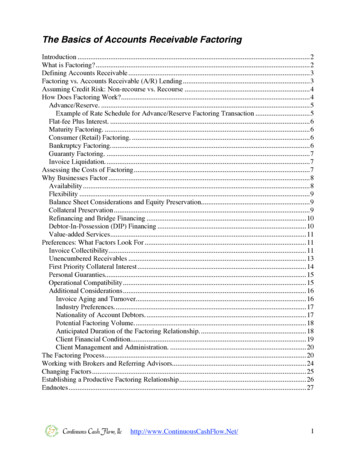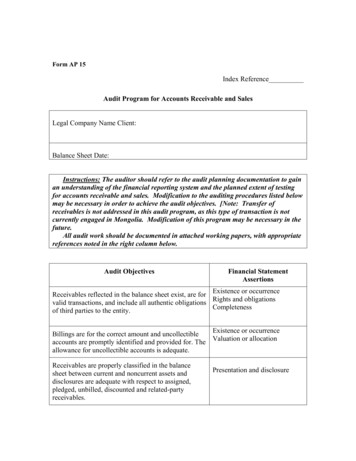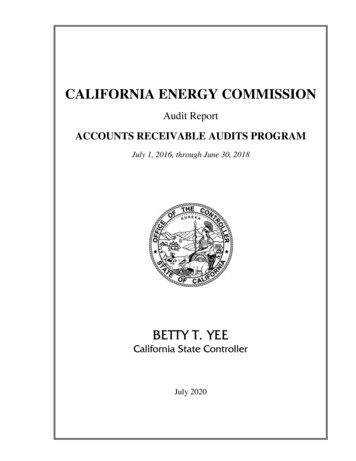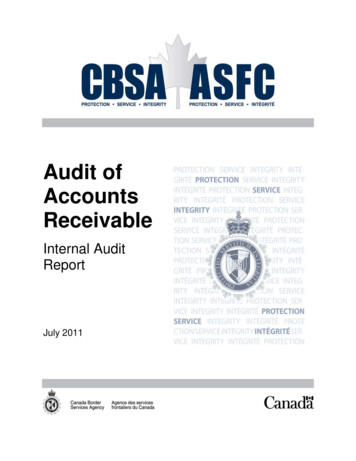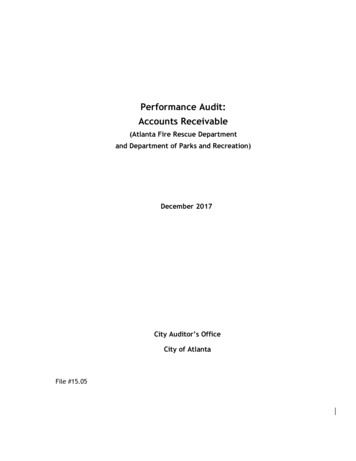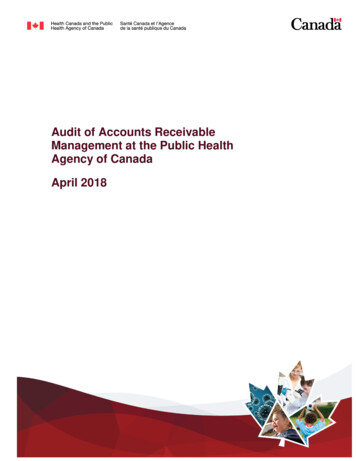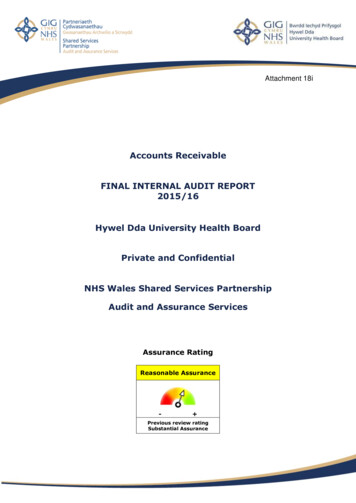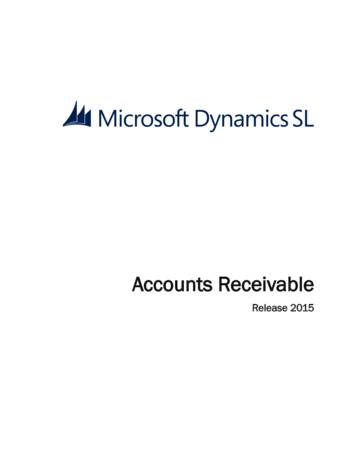
Transcription
Accounts ReceivableRelease 2015
DisclaimerThis document is provided “as-is”. Information and views expressed in this document, including URLand other Internet Web site references, may change without notice. You bear the risk of using it.Some examples are for illustration only and are fictitious. No real association is intended or inferred.This document does not provide you with any legal rights to any intellectual property in any Microsoftproduct. You may copy and use this document for your internal, reference purposes only.Sample Code Warranty disclaimerMicrosoft Corporation disclaims any warranty regarding the sample code contained in thisdocumentation, including the warranties of merchantability and fitness for a particular purpose.License agreementUse of this software is covered by a license agreement provided with it. If you have any questions,please call the Customer Assistance Department at 800-456-0025 (in the United States or Canada) or 1-701-281-6500.Copyright 2014 Microsoft Corporation. All rights reserved.Publication DateSeptember 2014
ContentsiiiContentsIntroduction1Accounts Receivable Interaction . 2Manual Overview . 3What is Covered in the Manual? . 3Who Should Use the Manual? . 3How to Use the Manual . 3Quick Reference Task List . 4How Do I Define.? . 4How Do I Set Up.? . 4How Do I Establish.? . 4How Do I Enter.? . 4Setting up Accounts Receivable5Overview . 5Before You Begin . 5Structuring Accounts Receivable Coding . 5Accounts Receivable Record Coding Formats . 6Accounts Receivable Setup . 9Defining Statement Cycles . 11Defining Customer Classes . 12Setting Up General Ledger Accounts . 14Defining the Fiscal Period . 16Defining Customer Defaults . 18Setting up Finance Charges . 20Defining Accounts Receivable System-Level Decisions . 22Defining Sales Territories . 24Entering Salesperson Information . 25Establishing Salesperson History . 26Setting up Customer Accounts29Overview . 29Before You Begin . 29Customer Status . 30Terms and Pricing . 30Entering Customer Information . 31Entering Customer Addresses . 33Entering Customer Defaults . 34Entering a Customer’s Other Options . 36Entering Customer Order Management Information . 37Entering Customer Order Management Account Information . 38Entering Customer Quick Send Preferences . 39Entering Customer Shipping Addresses . 43Establishing Customer History . 44Processing Accounts Receivable Transactions45Overview . 45Processing Accounts Receivable Transactions . 46Accounts Receivable Transaction Flow . 47Processing Foreign-Denominated Transactions . 48Processing Taxes . 48Establishing Accounts Receivable History . 49Entering Invoices, Debit Memos, and Credit Memos . 50Setting Up Recurring Invoices . 54
ivAccounts ReceivableSetting Up Multiple Installments . 57Confirming Invoices Generated Using Order Management . 58Overriding Taxes for the Transaction . 60Generating Recurring Invoices . 61Applying Payments, Prepayments, and Credit Memos . 63Applying Payments Manually . 65Writing Off Small Balances during Payment Application . 66Applying Payments and Credit Memos Automatically . 67Applying Payments for Counter Sales . 69Changing the Document Sort Order . 71Entering Payments or Prepayments . 72Auto-Applying Payments to Multiple Customers . 74Reversing Payments . 75Writing Off Small Balances and Credits . 77Distributing a Write-off Among Several Accounts . 78Printing Accounts Receivable Batch Control Reports. 79Releasing Accounts Receivable Batches . 80Calculating Customer Finance Charges . 81Aging Customer Balances . 82Closing Statement Cycles . 83Printing Customer Statements . 84Closing Accounts Receivable . 85Reviewing Accounts Receivable Information87Overview . 87Reviewing Accounts Receivable Documents . 88Looking Up Customer Information. 89Looking Up Customer Shipping Addresses . 91Reviewing Customer History . 92Reviewing Customer Account Activity. 94Looking Up Customer Account Balances . 96Finding a Customer . 99Looking up a Customer’s Open Orders .100Looking Up Customer Payments .101Looking Up Salesperson Information .102Reviewing Salesperson History.103Printing Reports .104Previewing Invoices, Debit Memos, and Credit Memos .105Printing Invoices, Debit Memos, and Credit Memos .106Sending Documents Electronically .107Viewing Quick Send Request Details .111Maintaining Accounts Receivable Data113Overview .113Accounts Receivable Troubleshooting .113Editing Accounts Receivable Documents.114Confirming and Applying Order Management Adjusting Memos .115Deleting Accounts Receivable Data .117Checking Accounts Receivable Data Integrity .118Data Entry Screens119Invoice and Memo (08.010.00) .119Invoice and Memo, Invoice/Memo Tab .126Invoice and Memo, Account Override Tab .129Tax .131One-time Receiver (08.010.01) .133Terms Details (08.010.02) .137
ContentsvInvoice Preview (08.010.03) . 138Payment Application (08.030.00) . 139Payment Application, Payment/Memo Tab . 145Payment
The Accounts Receivable module in Microsoft Dynamics SL performs the functions needed to process customer invoices and maintain accounts receivable information. In addition, it generates a wide variety of useful accounts receivable reports that help make customer account management easier and more efficient. And with the Doc Share feature .
